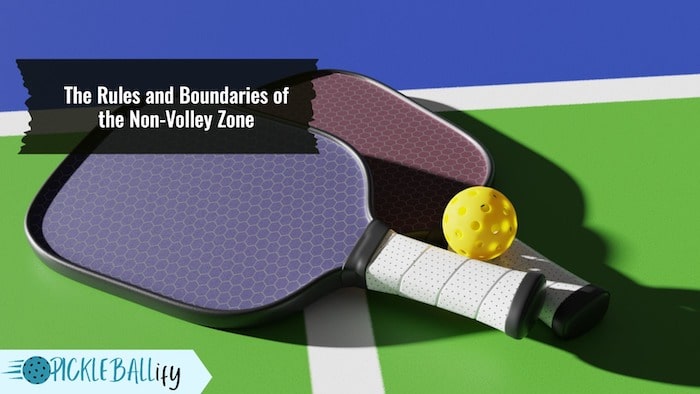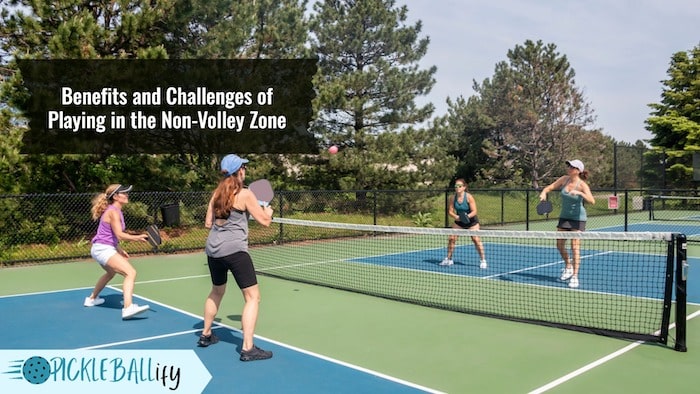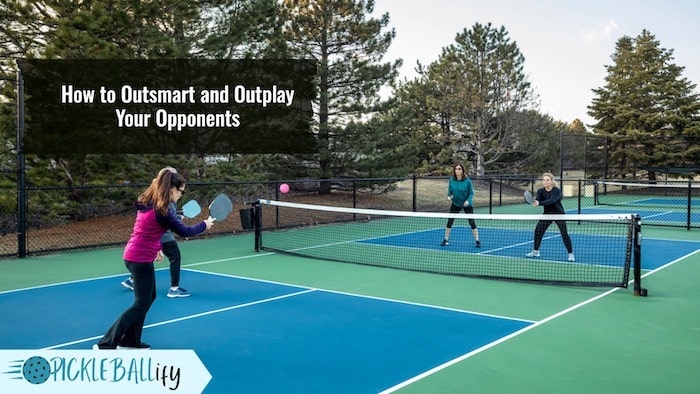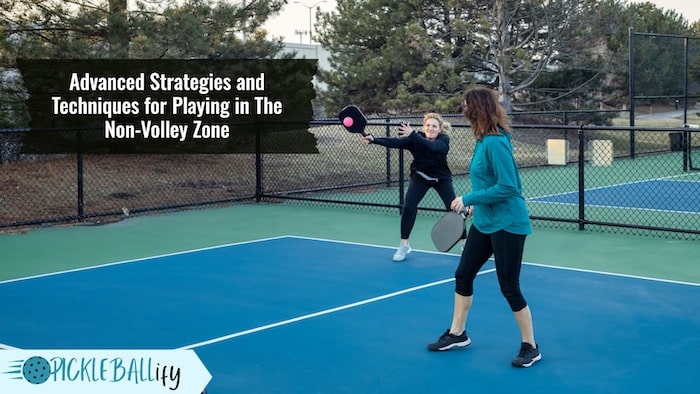Pickleball is an interesting and engaging sport that mixes aspects of tennis, badminton, and ping-pong. It may be played by individuals of all ages and ability levels, and it has several health and fitness advantages. But, if you want to play pickleball properly, you must first comprehend one of its most crucial and distinguishing characteristics, the non-volley zone.

The non-volley zone, often called as the kitchen, is the region of the court on both sides that extends 7 feet from the net. It is distinguished by a line that divides it from the rest of the court. There are certain specific regulations in the non-volley zone that govern how you may play the ball and where you can stand.
In this article, we will explore the rules and boundaries of the non-volley zone, the benefits and challenges of playing in it, the best shots and moves to use in it, and the common errors and pitfalls to avoid in it. By the end of this article, you will have a better understanding of how to use the non-volley zone as your secret weapon in pickleball.
What is the Non-Volley Zone?
The non-volley zone is the section of the court where you are not permitted to volley or strike the ball in the air. A volley is when you strike the ball before it hits the ground. You earn a foul and lose the point if you volley the ball while standing in the non-volley zone or while touching any portion of it.
The non-volley zone’s objective is to make the game more difficult and equitable for both sides. It keeps players from getting too near to the net and pounding the ball down at their opponents, making it tough to return.
Since players must wait for the ball to bounce before striking it in the non-volley zone, it encourages longer rallies and greater strategy.
The Rules and Boundaries of the Non-Volley Zone
The basic rules of the non-volley zone are fairly simple, but they can be tricky to follow at times. Here are some dos and don’ts of playing in the kitchen:

- You cannot hit the ball in the air while standing in the non-volley zone. You must let the ball bounce first before hitting it. This applies to both singles and doubles play.
- You cannot hit the ball in the air while your momentum carries you into the non-volley zone. You must establish yourself outside of the zone before hitting a volley. This means that you cannot step into or touch any part of the non-volley zone with any part of your body or paddle until after you hit a volley.
- You cannot hit a volley if any part of your body or paddle touches any part of the non-volley zone line. The line is considered part of the zone, so touching it counts as being in it.
“When volleying the ball, the player may not step on or over the line. It is a fault if the player’s momentum causes the player or anything the player is wearing or carrying to touch the non-volley zone.” stated in the International Federation of Pickleball.
- You can hit a volley while standing outside of the non-volley zone line, even if your paddle swings over or into the zone after you hit the ball. As long as you do not touch any part of the zone with any part of your body or paddle before or during contact with the ball, you are good to go.
- You can enter or exit the non-volley zone at any time as long as you do not hit a volley while in it or while your momentum carries you into it. You can also stand in or move around in the non-volley zone as long as you let the ball bounce before hitting it.
Benefits and Challenges of Playing in the Non-Volley Zone
Playing in the non-volley zone has many benefits for your pickleball game. Some of the benefits are:

- You can control the pace and direction of the rally by using soft shots like dinks and drops.
- You can create angles and openings to attack your opponents’ weak spots or force them to make errors.
- You can reduce your opponents’ options and opportunities to hit hard shots or winners.
- You can cover more court and be ready for any shot that comes your way.
However, playing in the non-volley zone also has some challenges that you need to overcome. Some of the challenges are:
- You need to have good balance and footwork to move in and out of the zone without touching it or committing a fault.
- You need to have good hand-eye coordination and paddle control to hit accurate and consistent shots while staying low to the ground.
- You need to have good anticipation and reaction skills to handle fast or unexpected shots from your opponents.
- You need to have good communication and teamwork with your partner to avoid confusion or collisions.
How to Outsmart and Outplay Your Opponents
When you are playing in the non-volley zone, you need to use different shots and moves to gain an advantage over your opponents. Some of the best shots and moves to use in the non-volley zone are:

1) The Dink:
The dink is a soft shot that barely clears the net and lands in your opponent’s non-volley zone. The dink is a great shot to use because it forces your opponents to hit up on the ball, which gives you a chance to attack or wait for their mistake.
The dink also allows you to control the pace and direction of the rally by changing the angle, speed, spin, or depth of your shot. To hit a good dink, you need to use a soft grip, a short backswing, a gentle push or slice motion, and a low-to-high follow-through.
You also need to aim for the center of the ball and hit it just above the net. You can hit dinks crosscourt or straight-on, depending on where your opponents are positioned and where you want them to move.
2) The Lob:
The lob is a high shot that goes over your opponents’ heads and lands near their baseline. The lob is a great shot to use when you want to change the pace or direction of the rally, or when you want to push your opponents back and create space for yourself at the net.
The lob also allows you to recover from a defensive position or catch your breath. To hit a good lob, you need to use a soft grip, a high backswing, a gentle push or slice motion, and a high follow-through.
You also need to aim for the center of the ball and hit it with enough height and depth to clear your opponent’s reach. You can hit lobs crosscourt or straight-on, depending on where your opponents are positioned and where you want them to move.
3) The Speed-Up:
The speed-up is a hard shot that hits the ball low and fast over the net. The speed-up is a great shot to use when you want to surprise or pressure your opponents, or when you want to end the rally with a winner.
The speed-up also allows you to take advantage of a high or weak ball from your opponents or exploit their gaps in coverage. To hit a good speed-up, you need to use a firm grip, a short backswing, a quick snap or punch motion, and a low follow-through.
You also need to aim for the top of the ball and hit it with enough power and accuracy to pass your opponents or make them miss. You can hit speed-ups crosscourt or straight-on, depending on where your opponents are positioned and where you want them to move.
4) The Erne Shot:
The Erne shot is an advanced shot that involves jumping around the non-volley zone and hitting a volley from outside of it. The Erne shot is a great shot to use when you want to catch your opponents off guard or when you want to take away their angle or time.
The Erne shot also allows you to be aggressive and creative on the court. To hit a good Erne shot, you need to have good anticipation, footwork, timing, and balance. You also need to avoid touching the non-volley zone or line with any part of your body or paddle before or during contact with the ball.
You can hit Erne shots crosscourt or straight-on, depending on where your opponents are positioned and where you want them to move.
5) The Put Away:
The putaway is a hard shot that hits the ball down and fast over the net. The putaway is a great shot to use when you want to end the rally with a winner or when you want to punish your opponents for a high or weak ball.
The put-away also allows you to be decisive and confident on the court. To hit a good putaway, you need to use a firm grip, a short backswing, a quick snap or punch motion, and a low follow-through.
You also need to aim for the top of the ball and hit it with enough power and accuracy to pass your opponents or make them miss. You can hit put-aways crosscourt or straight-on, depending on where your opponents are positioned and where you want them to move.
Advanced Strategies and Techniques for Playing in The Non-Volley Zone
Playing in the non-volley zone requires more than just knowing the basic shots and moves. It also requires having a good strategy and technique to outsmart and outplay your opponents. Here are some advanced strategies and techniques for playing in the non-volley zone:

Mix Up Your Shots
One of the best ways to keep your opponents guessing and off balance is to mix up your shots in the non-volley zone. Don’t just hit the same shot over and over again. Vary your speed, spin, angle, depth, and placement of your shots.
For example, you can hit a crosscourt dink followed by a straight-on drop, or a lob followed by a speed-up. By mixing up your shots, you can create openings and opportunities to attack or force errors from your opponents.
Use Your Non-Dominant Hand
Another way to improve your skills and options in the non-volley zone is to use your non-dominant hand to make shots. This can give you more reach, angle, and control over the ball.
For example, you can use your non-dominant hand to hit a backhand dink or drop from the middle of the court or hit a forehand volley, or put away from the sideline. By using your non-dominant hand, you can surprise your opponents and make shots that they are not expecting or prepared for.
Anticipate and React
One of the most important skills to have in the non-volley zone is the ability to anticipate and react to your opponent’s shots. You need to be able to read their body language, paddle position, and ball trajectory to predict where they are going to hit the ball. You also need to be able to move quickly and adjust your paddle angle and swing to respond to their shots.
For example, you can anticipate a lob by looking at their high backswing and paddle face, and react by moving back and hitting an overhead. Or you can anticipate a speed-up by looking at their low backswing and paddle face, and react by blocking or redirecting their shot.
By anticipating and reacting well, you can gain an advantage over your opponents and win more points.
Communicate and Work with Your Partner
One of the most essential aspects of playing in the non-volley zone is communicating and working with your partner. You need to be on the same page with your partner about who is covering which shots and areas of the court, who is taking charge of the rally, and what signals or cues you are using to communicate.
You also need to support and encourage your partner throughout the game. For example, you can communicate with your partner by calling “mine” or “yours” when a ball is hit down the middle, by pointing or nodding when you want them to switch sides or take a shot, or by saying “good shot” or “nice try” when they make a good or bad play.
By communicating and working well with your partner, you can avoid confusion, collisions, missed shots, or gaps in coverage.
FAQs
Players may enhance their non-volley zone performance by working on their footwork, and soft touch strokes, and learning to anticipate their opponent’s shots. To move fast and efficiently, it is also necessary to maintain balance and a low center of gravity.
Common mistakes include stepping into the non-volley zone too early, hitting the ball out of the air from the non-volley zone, and failing to move quickly and efficiently around the non-volley zone.
No, players are not allowed to touch the net at any time during the game, including while standing in the non-volley zone. Doing so results in a fault and the opposing team receives the point.
Yes, players may enter the non-volley zone to strike a ball that has rebounded there, as long as they do not hit the ball out of the air from the non-volley zone.
Conclusion
In conclusion, the non-volley zone is a key component of pickleball that encourages more rallies and strategic gameplay. Players must adhere to the non-volley zone rule, which prohibits hitting the ball out of the air while standing in the non-volley zone.
By practicing their footwork, developing soft touch shots, and learning to anticipate their opponent’s shots, players can improve their play in the non-volley zone and become more skilled pickleball players.

